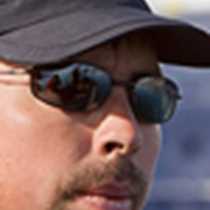Halvmåneøya, Southeastern Nature Reserve
As we are steaming along the Spitsbergen coast, we have seen some minke whales and seals. There are also great numbers of seabirds out feeding in the sea, as this is one of the richest seas in the northern hemisphere.
As we passed the southern end of Edgeøya, we started seeing the ice we are heading towards. Seeing the first ice, we were also lucky to see two polar bears. It was a mother with a year-old cub. They were sleeping as we approached them, and doing the same as we left them.
For polar bears it is important not to disturb them unnecessarily, as they need to save all their energy for the long and harsh winter that will come soon after the short arctic summer.
We continued on east side of Egdeøya up to a small island called Halvmåneøya (Halfmoon Island). This is one of the most famous places for polar bears here in Svalbard. There is a migration route passing this island, and in summer there is also a lot of pack ice drifting by. This is one of the reasons that Paul Nicklen, the National Geographic Photographer, chose to be dropped off at this island, where he will spend at least one week with his assistant Shaun Powell. We wish them good luck in this polar bear land.
Halvmåneøya has also been one of the most commonly used trapper stations for hunting polar bears. When you hear about catches up to 150 polarbears in just one winterseason, you can understand how easy it is to decimate a population, as has been done up here on Svalbard for so many years and on so many species in the past. Hopefully this will change, as the Norwegian government has a goal to make Svalbard’s nature the best managed wildlife area in the world.
With that hope, we continue into the pack ice looking for more polar bears...
As we are steaming along the Spitsbergen coast, we have seen some minke whales and seals. There are also great numbers of seabirds out feeding in the sea, as this is one of the richest seas in the northern hemisphere.
As we passed the southern end of Edgeøya, we started seeing the ice we are heading towards. Seeing the first ice, we were also lucky to see two polar bears. It was a mother with a year-old cub. They were sleeping as we approached them, and doing the same as we left them.
For polar bears it is important not to disturb them unnecessarily, as they need to save all their energy for the long and harsh winter that will come soon after the short arctic summer.
We continued on east side of Egdeøya up to a small island called Halvmåneøya (Halfmoon Island). This is one of the most famous places for polar bears here in Svalbard. There is a migration route passing this island, and in summer there is also a lot of pack ice drifting by. This is one of the reasons that Paul Nicklen, the National Geographic Photographer, chose to be dropped off at this island, where he will spend at least one week with his assistant Shaun Powell. We wish them good luck in this polar bear land.
Halvmåneøya has also been one of the most commonly used trapper stations for hunting polar bears. When you hear about catches up to 150 polarbears in just one winterseason, you can understand how easy it is to decimate a population, as has been done up here on Svalbard for so many years and on so many species in the past. Hopefully this will change, as the Norwegian government has a goal to make Svalbard’s nature the best managed wildlife area in the world.
With that hope, we continue into the pack ice looking for more polar bears...



